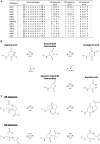Characterization of Adeno-Associated Virus Capsid Proteins with Two Types of VP3-Related Components by Capillary Gel Electrophoresis and Mass Spectrometry
- PMID: 34082578
- PMCID: PMC10112878
- DOI: 10.1089/hum.2021.009
Characterization of Adeno-Associated Virus Capsid Proteins with Two Types of VP3-Related Components by Capillary Gel Electrophoresis and Mass Spectrometry
Abstract
Recombinant adeno-associated virus is a leading platform in human gene therapy. The adeno-associated virus (AAV) capsid is composed of three viral proteins (VPs): VP1, VP2, and VP3. To ensure the safety of AAV-based gene therapy products, the stoichiometry of VPs of AAV vector should be carefully monitored. In this study, sodium dodecyl sulfate-polyacrylamide gel electrophoresis, capillary gel electrophoresis (CGE), and liquid chromatography-UV-mass spectrometry (LC-UV-MS) were performed to evaluate the VP components of AAV1, AAV2, and AAV6. Two types of VP3-related components, VP3 variant and VP3 fragment, were identified. The VP3 variant was the N-terminal shorter VP3, of which the translation started at M211, not at the conventional initiation codon, M203. The VP3 variant could be generated by leaky scanning of the first initiation codon of VP3. We also showed that the VP3 variant was identified in a minor peak before VP3 in CGE measurement. Meanwhile, the VP3 fragment was the C-terminal cleaved VP3, of which the sequence of VP3 ended at D590 or D626, indicating that cleavage occurred between D590 and P591, or D626 and G627. The cause of the cleavage of the DP or DG sequence was hydrolysis due to low pH of the mobile phase and high temperature of the column oven in the LC system, which was necessary to clearly separate the peak of VPs. VP3 fragments, detected only in LC-UV-MS in small amount account with less than 3% of total peak area, should be included in the quantification of VP3. Finally, the relationship of VP stoichiometry determined by the above three methods was discussed. From this study, we proposed that the VP components of AAV should be complementarily evaluated by CGE and LC-UV-MS.
Keywords: adeno-associated virus; capillary gel electrophoresis; mass spectrometry; viral protein.
Conflict of interest statement
No competing financial interests exist.
Figures





Similar articles
-
Direct Liquid Chromatography/Mass Spectrometry Analysis for Complete Characterization of Recombinant Adeno-Associated Virus Capsid Proteins.Hum Gene Ther Methods. 2017 Oct;28(5):255-267. doi: 10.1089/hgtb.2016.178. Epub 2017 Jun 16. Hum Gene Ther Methods. 2017. PMID: 28627251
-
Characterization of Adeno-Associated Virus Capsid Proteins by Microflow Liquid Chromatography Coupled with Mass Spectrometry.Appl Biochem Biotechnol. 2024 Mar;196(3):1623-1635. doi: 10.1007/s12010-023-04656-x. Epub 2023 Jul 12. Appl Biochem Biotechnol. 2024. PMID: 37436544
-
Rapid characterization of adeno-associated virus (AAV) capsid proteins using microchip ZipChip CE-MS.Anal Bioanal Chem. 2024 Feb;416(4):1069-1084. doi: 10.1007/s00216-023-05097-5. Epub 2023 Dec 15. Anal Bioanal Chem. 2024. PMID: 38102410 Free PMC article.
-
Chimeric Capsid Proteins Impact Transduction Efficiency of Haploid Adeno-Associated Virus Vectors.Viruses. 2019 Dec 9;11(12):1138. doi: 10.3390/v11121138. Viruses. 2019. PMID: 31835440 Free PMC article.
-
Mass spectrometry in gene therapy: Challenges and opportunities for AAV analysis.Drug Discov Today. 2023 Jan;28(1):103442. doi: 10.1016/j.drudis.2022.103442. Epub 2022 Nov 14. Drug Discov Today. 2023. PMID: 36396118 Review.
Cited by
-
Quantification of Empty, Partially Filled and Full Adeno-Associated Virus Vectors Using Mass Photometry.Int J Mol Sci. 2023 Jul 3;24(13):11033. doi: 10.3390/ijms241311033. Int J Mol Sci. 2023. PMID: 37446211 Free PMC article.
-
Enhancement of recombinant adeno-associated virus activity by improved stoichiometry and homogeneity of capsid protein assembly.Mol Ther Methods Clin Dev. 2023 Oct 24;31:101142. doi: 10.1016/j.omtm.2023.101142. eCollection 2023 Dec 14. Mol Ther Methods Clin Dev. 2023. PMID: 38027055 Free PMC article.
-
Development of a Rapid Adeno-Associated Virus (AAV) Identity Testing Platform through Comprehensive Intact Mass Analysis of Full-Length AAV Capsid Proteins.J Proteome Res. 2023 Dec 20;23(1):161-74. doi: 10.1021/acs.jproteome.3c00513. Online ahead of print. J Proteome Res. 2023. PMID: 38123456 Free PMC article.
-
Physicochemical and biological impacts of light stress on adeno-associated virus serotype 6.Mol Ther Methods Clin Dev. 2024 Oct 28;32(4):101362. doi: 10.1016/j.omtm.2024.101362. eCollection 2024 Dec 12. Mol Ther Methods Clin Dev. 2024. PMID: 39624799 Free PMC article.
-
Adeno-associated virus serotype 2 capsids with proteolytic cuts by trypsin remain intact and potent.Gene Ther. 2025 Mar;32(2):121-131. doi: 10.1038/s41434-024-00507-4. Epub 2024 Nov 29. Gene Ther. 2025. PMID: 39613903 Free PMC article.
References
Publication types
MeSH terms
Substances
LinkOut - more resources
Full Text Sources
Other Literature Sources
